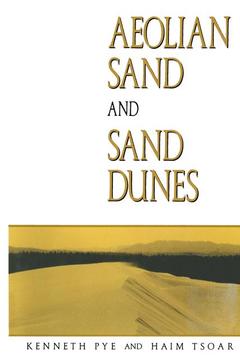Aeolian sand and sand dunes, Softcover reprint of the original 1st ed. 1990
Langue : Anglais
Auteurs : Pye K., Tsoar H.

It is almost exactly half a century since the publication of R. A. Bagnold's classic book The physics of blown sand and desert dunes, and it is a tribute to the quality of Bagnold's work that many of the fundamental principles which he developed remain valid today. His book continues to be essential reading for any serious student of aeolian processes. However, the past two decades have seen an explosion in the scale of research dealing with aeolian transport processes, sediments, and landforms. Some of this work has been summarized in review papers and edited conference proceedings, but this book provides the first attempt to review the whole field of aeolian sand research. Inevitably, it has not been possible to cover all aspects in equal depth, and the balance of included material naturally reflects the authors' own interests to a significant degree. However, our aim has been to provide as broad a perspective as possible, and to provide an entry point to an extensive multi-disciplinary scientific literature, some of which has not been given the attention it deserves in earlier textbooks and review papers. Many examples are drawn from existing published work, but the book also makes extensive use of our own research in the Middle East, Australia, Europe, and North America. The book has been written principally for use by advanced undergraduates, post graduates, and more senior research workers in geomorphology and sedimentology.
1 The nature and importance of aeolian sand research.- 1.1 Definitions.- 1.2 Previous work.- 1.3 Future research requirements.- 2 The nature of airflow.- 2.1 Physical properties of air and the Earth’s atmosphere.- 2.2 Nature and types of air motion.- 2.3 Storm types that generate sand-transporting winds.- 2.4 Flow in the atmospheric boundary layer.- 3 Characteristics of windblown sediments.- 3.1 General properties of sediment grains.- 3.2 Grain shape.- 3.3 Porosity, permeability, and packing of sands.- 3.4 Grain size characteristics of aeolian sediments.- 3.5 Shape characteristics of aeolian dune sands.- 3.6 Surface textures of aeolian sands.- 3.7 Porosity and permeability of aeolian sands.- 3.8 Sources and mineral composition of aeolian dune sand.- 4 Mechanics of aeolian sand transport.- 4.1 Particle entrainment.- 4.2 Transport of particles by the wind.- 5 The formation of sand seas and dunefields.- 5.1 Definition of sand seas and dunefields.- 5.2 Global distribution of sand seas.- 5.3 Factors controlling the distribution and magnitude of sand seas.- 5.4 Development of sand seas in relation to topography.- 5.5 Wind regime and regional sandflow paths.- 5.6 Evolution of ergs in response to climatic changes.- 5.7 Effect of sea-level changes on coastal dunefields.- 5.8 Effect of sea-level changes on continental dunefields.- 6 Aeolian bedforms.- 6.1 Types of aeolian sand accumulation and bedform terminology.- 6.2 Ripples.- 6.3 Sand dunes.- 6.4 Vegetated dunes.- 6.5 Sand sheets.- 6.6 Summary of factors determining the morphology of aeolian sand accumulations.- 7 Internal sedimentary structures of aeolian sand deposits.- 7.1 Introduction.- 7.2 Internal structures of sand dunes.- 7.3 Secondary sedimentary structures in dunes.- 7.4 Sedimentary structures of interdune areas and sand sheets.- 7.5 Niveo-aeolian deposits and cryogenic structures in cold-climate dunes.- 8 Post-depositional modification of dune sands.- 8.1 Introduction.- 8.2 Denudation by rain splash, surface wash, soil creep, and gullying.- 8.3 Near-surface compaction.- 8.4 Addition of allochthonous components.- 8.5 Weathering and pedogenesis of siliceous dune sands.- 8.6 Formation of carbonate aeolianites.- 8.7 Early diagenetic cementation by evaporite minerals.- 9 Management and human use of sand dune environments.- 9.1 Thermal properties of sand, moisture regime, and vegetation growth.- 9.2 Water courses in dune areas.- 9.3 Control of windblown sand.- 9.4 Human use of sand dune areas.- 10 Aeolian research techniques.- 10.1 Wind tunnel studies.- 10.2 Measurement of sand movement using sand traps.- 10.3 Sand tracer techniques.- 10.4 Methods of sample collection for grain size and mineralogical analysis.- 10.5 Methods of determining the grain size of sands.- 10.6 Characterization of airflow.- 10.7 Methods of monitoring changes in sand dune terrain.- Appendix I. SI units and c.g.s. equivalents.- References.
Date de parution : 02-2012
Ouvrage de 416 p.
15.5x23.5 cm
Disponible chez l'éditeur (délai d'approvisionnement : 15 jours).
Prix indicatif 52,74 €
Ajouter au panierThèmes d’Aeolian sand and sand dunes :
Mots-clés :
© 2024 LAVOISIER S.A.S.



